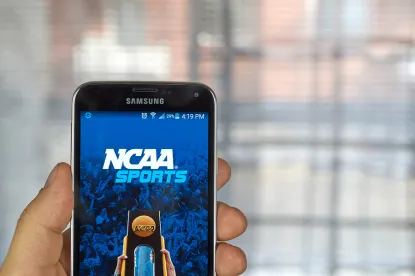The NCAA will allow college student-athletes to raise money for COVID-19 related causes after some controversy over a fundraiser arranged by Clemson quarterback Trevor Lawrence. Lawrence and his girlfriend started a GoFundMe to raise money for food for those struggling during the pandemic. According to ESPN, Clemson compliance officials asked Lawrence to stop the fundraiser, believing it was violating NCAA policy around an athlete profiting from the use of their name, image and likeness. However, the NCAA released a statement that they would allow Lawrence and other student athletes to raise money related to the COVID-19 pandemic.
These types of issues may soon be a thing of the past. This month, the NCAA’s Federal and State Legislation Working Group is expected to report their recommendations on how to allow athletes to profit for the use of their name, image and likeness.
This month, the NCAA Board of Governors is receiving updated recommendations from their Federal and State Legislation Working Group after they ruled in Oct. 2019 that they would allow student athletes the opportunity to profit for the use of their name, image and likeness. The three divisions of the NCAA are analyzing their rules, which they must complete by January 2021.
While we wait for details, there are important topics college student-athletes should begin to understand. One critical legal issue that college student-athletes need to consider is the importance of protecting their potential intellectual property early in their athletic career. Oftentimes, college student-athletes wait to focus on their image and intellectual property until they have declared their entrance into a professional league’s draft. It is during this time period when athletes begin thinking about entering into licensing deals, developing their brand, and preparing trademarks for the commercialization of their brand and image. With the pending changes to the NCAA rules, this timeline moves up and college student-athletes and their families need to start focusing on the following intellectual property issues.
Brand and Image
Given the new stance taken by the NCAA, the development, management and protection of an athlete’s brand will be more important than ever before. With the explosion of social media over the last decade, athletes are more aware of the brand they present to the world; however, the question these athletes need to analyze is: how do they want the public to view them? The outcome of this analysis will help them understand what types of marketing and endorsement deals should they enter into and for how long.
Understanding some of the typical provisions of an endorsement deal are critical for the protection of an athlete’s brand. Does the agreement establish category exclusivity? How long is the term? What is required of the athlete? How does a particular sponsorship or endorsement deal align, or not align, with their college’s sponsorship deals? If a conflict exists, how is it addressed? All of these questions should be addressed in the written marketing agreement. Further, an athlete should to seek advice on ensuring that these provisions are addressed, and addressed in a way that protects the athlete.
Another question that athletes will have to address is whether they are being fairly compensated for the use of their name, image and likeness. Ultimately, the market will determine what it is willing to pay a college student athlete. The metrics for making this decision already exist through looking at social media followers, name recognition, etc. The more of a celebrity an athlete is, the more they will be able to demand in endorsement deal compensation.
Trademarks
Another aspect of the name, image and likeness discussion that will impact college student-athletes is the need to protect their intellectual property. As athletes build their brand, trademark protection might become a necessity. A trademark can range from a players own name, nickname, brand name or logo, or even slogan or phrase that they have used (e.g. NBA’s Kawhi Leonard applying for the trademark “What It Do Baby” after gaining serious popularity in memes and social media postings following the 2019 NBA Finals). A trademark filing will be important, for those student-athletes who have a name, attribute or phrase that they want to commercialize (e.g. NBA’s Anthony Davis’ registered trademark for “Fear The Brow” playing on the nickname of his eyebrows).
When a student-athlete protects his or her brand by filing for a trademark registration, it allows the athlete to stop anyone else from using their intellectual property without their permission. Additionally, thinking about a potential company that wants to use a student-athlete as an endorser, the company will need to ensure it has an appropriate license to use that student-athlete’s intellectual property in its marketing and promotions. In order to protect itself, such a company will likely require that the athlete has protected their own intellectual property.
Domain Names
One additional area of intellectual property protection that college student-athletes (even high school athletes) should understand is domain name registration. An athlete can reserve their own domain name for a minimal amount, typically $15 – $40 per year. However, if they wait too long, they may find the domain name was reserved by someone else.
Some athletes have had the domain name for their own name reserved by someone else and when trying to secure that name, the original owner tries to sell it to the athlete for sometimes tens of thousands of dollars. In 2009, Chris Bosh brought a lawsuit and won in federal court against an organization that had reserved www.ChrisBosh.com and many other athlete domain names.
The Anti-cybersquatting Consumer Protection Act (ACPA), 15 U.S.C. § 1125(d), creates a cause of action for someone registering or using a domain name confusingly similar to a trademark or personal name. The law was established to try and stop “cyber squatters” who register domain names solely with the intention of selling the domain name to the person whose name it references at a profit.
While the law provides this protection, an athlete has to determine whether filing a lawsuit is worth the time and expense to get the domain name back. Oftentimes an athlete will simply use an alternate domain name, an uncommon top-level domain or create their own top-level domain. The lesson here is that athletes, at all levels, should register their name as their domain name in order to avoid these challenges.
Conclusion
While athletes like Trevor Lawrence have the temporary approval to fundraise during the COVID-19 crisis, profiting or from their name, image and likeness will become a reality for all student athletes over the next year. Athletes must protect themselves and ensure they take the appropriate precautions to protect their intellectual property.





 />i
/>i

